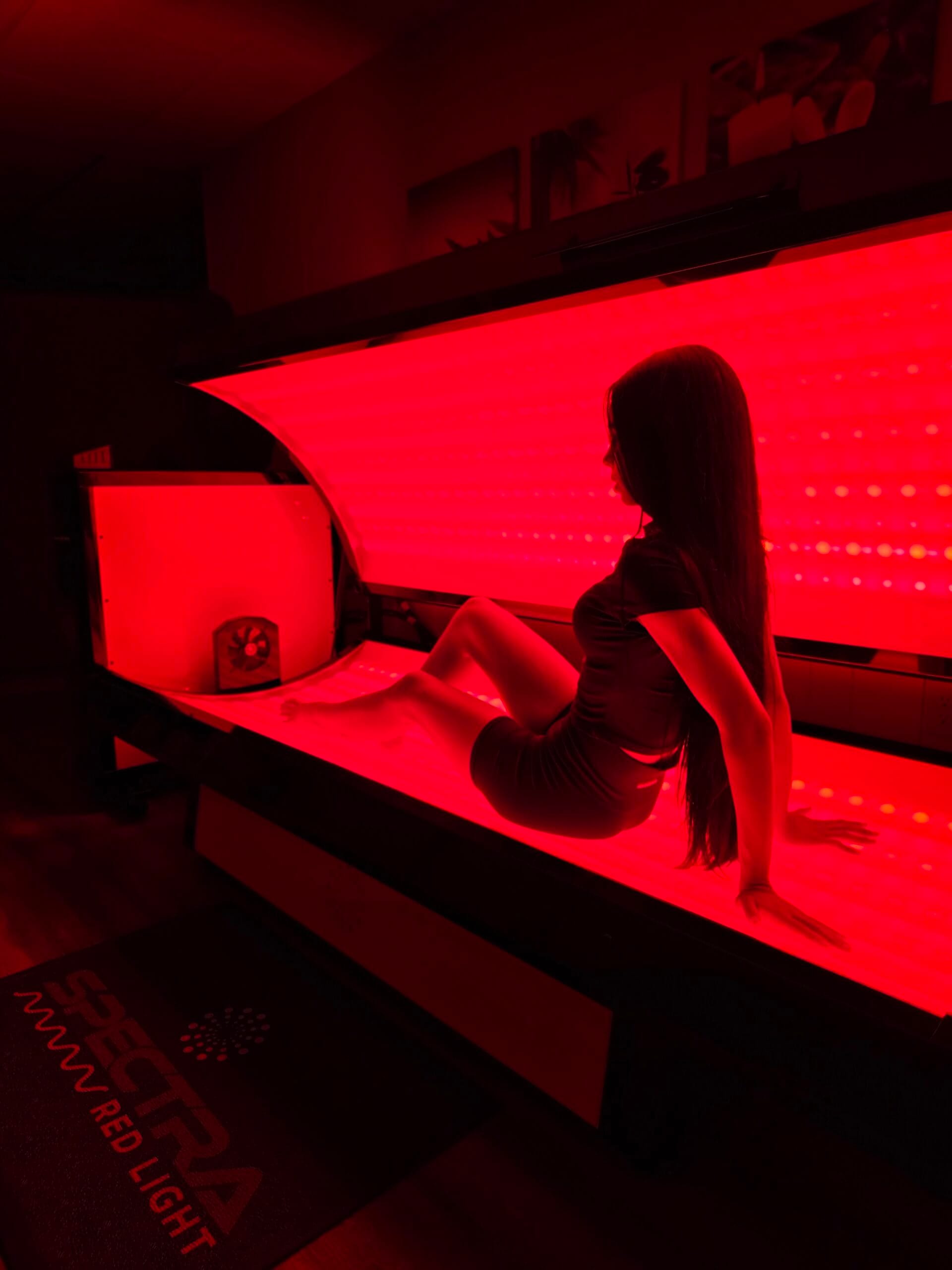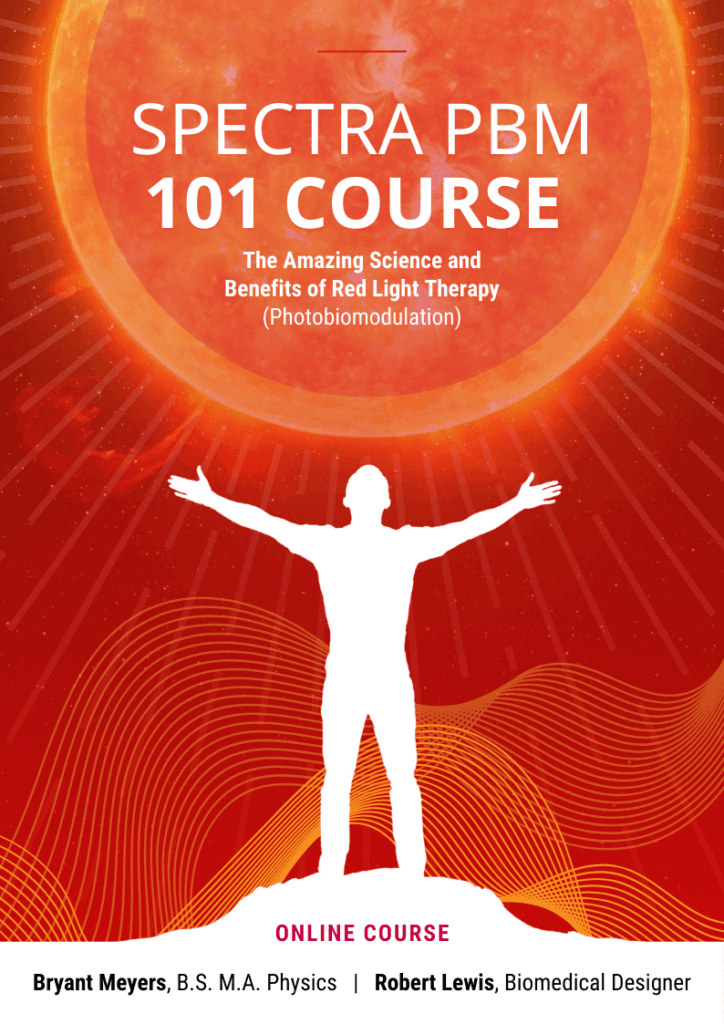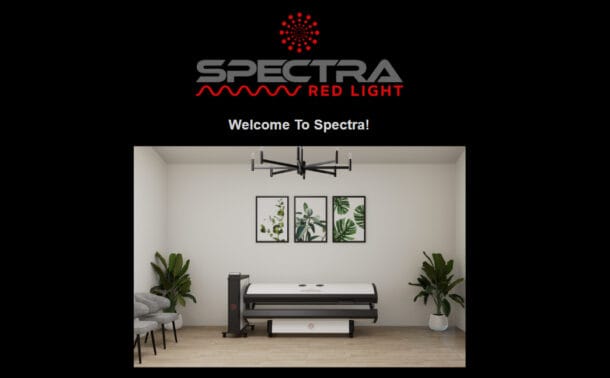According to the National Psoriasis Foundation, more than 7.5 million people in the United States are affected by psoriasis [1], making it one of the most prevalent chronic autoimmune skin disorders in the country. Characterized by red, scaly plaques and persistent inflammation, psoriasis stems from an overactive immune response that accelerates skin cell turnover and disrupts normal epidermal function.
This condition involves far more than surface symptoms, it reflects a deeper imbalance within the body’s immune and cellular systems. Fortunately, emerging therapies that support cellular repair and immune modulation are gaining attention for their ability to target these underlying mechanisms.
Red Light Therapy (RLT), also known as Photobiomodulation (PBM), is a non-invasive, light-based modality that delivers precise wavelengths of red and near-infrared light to the skin. These wavelengths are absorbed by cytochrome c oxidase within the mitochondria, leading to enhanced adenosine triphosphate (ATP) production, reduced oxidative stress, and modulation of pro-inflammatory signaling pathways.
Rather than simply masking symptoms, Red Light Therapy works at the cellular level to rebalance immune activity, restore skin integrity, and support tissue regeneration. For individuals seeking a therapy that aligns with the body’s own healing processes, Red Light Therapy offers a promising, science-backed approach to managing the complex physiology of psoriasis.
What Happens in the Skin During Psoriasis?
Psoriasis is more than a skin-deep condition, it’s a chronic, immune-mediated disorder that originates at the cellular and molecular levels. The hallmark of psoriasis is the hyperproliferation of keratinocytes, the primary cell type in the epidermis, coupled with persistent inflammation driven by dysregulated immune signaling.
At the core of this condition is an overactive immune response, particularly involving T-helper (Th1 and Th17) cells. These immune cells release pro-inflammatory cytokines, such as interleukin-17 (IL-17), interleukin-23 (IL-23), and tumor necrosis factor-alpha (TNF-α), which trigger a cascade of inflammatory reactions. This chronic immune activation accelerates the skin cell cycle, causing immature keratinocytes to build up on the skin surface in just 3–5 days instead of the normal 28–30-day cycle. The result: thick, scaly plaques that are often red, itchy, and painful.
In addition to keratinocyte overproduction, psoriasis also involves:
- Angiogenesis (formation of new capillaries in the dermis, contributing to redness and swelling),
- Impaired barrier function (increased transepidermal water loss),
- And heightened oxidative stress (an imbalance between free radicals and antioxidant defenses).
This complex interplay of immune dysregulation, mitochondrial dysfunction, and epidermal remodeling creates a chronic cycle that’s difficult to break using topical or systemic therapies alone.
Red Light Therapy offers a unique biological advantage in this context. By delivering targeted wavelengths that are absorbed by mitochondrial enzymes, especially cytochrome c oxidase, this therapy increases cellular respiration and ATP production, restoring energy balance in dysfunctional cells. Additionally, Red Light Therapy has been shown to downregulate inflammatory mediators like TNF-α and IL-6 while upregulating anti-inflammatory cytokines such as IL-10. This immune-modulating effect helps to normalize keratinocyte proliferation and supports the regeneration of a healthier epidermal barrier.
The stimulation of microcirculation and collagen synthesis promotes tissue repair and can reduce the visual appearance and physical discomfort of psoriatic lesions. For many, Red Light Therapy not only improves visible skin health but also targets the root biological mechanisms that perpetuate psoriasis.
In essence, Red Light Therapy doesn’t suppress the immune system; it supports its recalibration, helping the skin return to a more balanced and resilient state.
How Red Light Therapy Works at the Cellular Level
Red Light Therapy, also known in scientific literature as Photobiomodulation (PBM), is a non-invasive, light-based therapy that uses specific wavelengths of visible red and near-infrared (NIR) light to stimulate biological processes at the cellular level. It is not thermal in nature, meaning it does not burn or damage tissue. Instead, it works by delivering energy in the form of photons, which are absorbed by light-sensitive molecules within cells to promote healing, reduce inflammation, and restore function.
The key biological target of this therapy is cytochrome c oxidase (CCO), an enzyme in the mitochondrial respiratory chain. When red or near-infrared light is applied to the skin, it penetrates into the epidermal and dermal layers where it interacts with CCO, enhancing mitochondrial respiration and increasing the production of adenosine triphosphate (ATP), the energy currency of the cell.
In psoriasis, keratinocytes often suffer from mitochondrial dysfunction and oxidative stress, contributing to their abnormal proliferation and poor skin barrier performance. By improving ATP availability, RLT supports cellular repair, normalized differentiation, and reduced turnover rates in epidermal cells, helping to resolve the thickened, flaky plaques typical of the condition.
Additionally, Red Light Therapy modulates the immune system by:
- Reducing pro-inflammatory cytokines such as TNF-α, IL-1β, and IL-6
- Increasing anti-inflammatory mediators like interleukin-10 (IL-10)
- Suppressing the activity of overactive T-cells while encouraging a regulatory T-cell balance
- Improving microcirculation, delivering more oxygen and nutrients to the affected tissue
This combination of effects, cellular energy enhancement, immune modulation, antioxidant upregulation, and tissue regeneration, makes Red Light Therapy uniquely suited to address the multifactorial nature of psoriasis.
Unlike UV-based therapies, which rely on controlled photodamage and carry long-term risks such as DNA mutation or skin aging, Red Light Therapy works without ionizing radiation, making it safe for regular use on sensitive or inflamed skin.
For individuals with psoriasis, this means a therapy that not only calms flare-ups but also supports the skin’s restorative processes, working in harmony with the body to achieve healthier, more resilient skin over time.
Mechanisms of Action: How Red Light Therapy Targets Psoriasis at the Source
Psoriasis is driven by complex interactions between dysfunctional skin cells, oxidative stress, and dysregulated immune pathways. RLT, through the principles of photobiomodulation (PBM), addresses these core pathophysiological mechanisms in a targeted, non-invasive way. By delivering specific wavelengths of red and near-infrared light, this therapy initiates a cascade of biological effects that directly counteract the processes involved in psoriatic lesion formation and chronic inflammation.
Mitochondrial Activation and ATP Synthesis
At the center of Red Light Therapy’s effectiveness is its ability to stimulate mitochondrial function. When red and near-infrared photons penetrate the skin, they are absorbed by cytochrome c oxidase (CCO), a key enzyme in the electron transport chain. This photon absorption:
- Enhances electron transfer within mitochondria
- Increases production of adenosine triphosphate (ATP)
- Optimizes cellular metabolism and energy availability
For psoriatic skin, where keratinocytes are metabolically overactive yet functionally inefficient, increased ATP allows for improved cell differentiation and a normalization of the rapid cell turnover cycle. This contributes to smoother skin texture, reduced plaque thickness, and a stronger skin barrier.
Immune Modulation and Inflammatory Control
Psoriasis is characterized by the upregulation of Th1 and Th17 pathways, leading to the production of inflammatory cytokines such as TNF-α, IL-17, IL-6, and IL-23. These cytokines maintain a chronic state of immune activation and keratinocyte hyperproliferation.
Red Light Therapy has been shown to:
- Downregulate pro-inflammatory cytokines (e.g., TNF-α, IL-1β, IL-6)
- Upregulate anti-inflammatory mediators like interleukin-10 (IL-10)
- Suppress activation of dendritic cells and T-helper cells
- Promote immune homeostasis through modulation of regulatory T cells (Tregs)
This immunological rebalancing helps reduce both the visible inflammation (redness, swelling) and the internal immune overactivity that drives recurrent flare-ups.
Reduction of Oxidative Stress
Oxidative stress is a key component in the pathogenesis of psoriasis, contributing to DNA damage, lipid peroxidation, and further immune activation. Red Light Therapy helps restore redox balance by:
- Increasing the activity of endogenous antioxidants like superoxide dismutase (SOD) and glutathione peroxidase
- Reducing levels of reactive oxygen species (ROS) in psoriatic lesions
- Supporting mitochondrial integrity and function under inflammatory stress
By mitigating oxidative damage, RLT preserves cellular health and helps break the cycle of inflammation and tissue injury.
Enhanced Microcirculation and Tissue Oxygenation
Photobiomodulation stimulates the release of nitric oxide (NO) from intracellular stores, leading to vasodilation and increased local blood flow. This effect:
- Improves oxygen and nutrient delivery to affected skin
- Facilitates lymphatic drainage and removal of inflammatory byproducts
- Supports the regeneration of healthy skin tissue
Improved microcirculation is particularly important in psoriasis, where dermal blood vessel dilation is both a symptom and contributor to inflammation.
Stimulation of Growth Factors and Skin Repair
Red Light Therapy promotes the release of fibroblast growth factor (FGF) and vascular endothelial growth factor (VEGF), which play roles in tissue remodeling and regeneration. This leads to:
- Enhanced collagen synthesis
- Accelerated wound healing
- Restoration of epidermal and dermal structure
These processes help psoriatic skin transition from a state of chronic damage to one of active repair and resilience.
Together, these cellular and molecular actions demonstrate that RLT does more than soothe the surface of the skin; it works deep within the tissue to restore balance, reduce pathological inflammation, and support the long-term recovery of healthy skin function in individuals with psoriasis.

Clinical Evidence Supporting Red Light Therapy for Psoriasis
The growing interest in this therapy, also known as photobiomodulation (PBM), has been supported by a steady accumulation of clinical and preclinical studies, many of which demonstrate its potential in managing chronic inflammatory skin disorders, including psoriasis.
While traditional phototherapy has historically relied on ultraviolet light (UVA or UVB) to slow keratinocyte proliferation, newer approaches using visible red and near-infrared light via LED-based systems are gaining clinical attention due to their non-ionizing, non-damaging mechanism of action and impressive safety profile.
Red and Blue Light: Comparative Effects on Psoriatic Lesions
A notable randomized, double-blind comparative study published under the title Efficacy of blue light vs. red light in the treatment of psoriasis evaluated the effects of different visible wavelengths on psoriatic plaques. The authors concluded:
“The clinical improvement of psoriasis, with respect to erythema, in particular after blue light and to a lesser extent after red light indicates that visible light treatment could represent a treatment option for psoriasis.” [2]
Although this study highlighted stronger erythema reduction from blue light, the red light still yielded visible clinical improvement, particularly in the reduction of inflammation and plaque thickness. Red wavelengths are also known to penetrate deeper into the dermis, stimulating mitochondrial function and modulating inflammatory cytokines, which is vital in long-term skin healing and immune regulation.
LED-Based Photobiomodulation in Dermatology Practice
In a broader clinical context, a review titled Phototherapy with Light Emitting Diodes: Treating a Broad Range of Medical and Aesthetic Conditions in Dermatology examined the use of LED-based PBM across various skin and systemic conditions. The researchers stated:
“We determined that phototherapy using LEDs is beneficial for a range of medical and aesthetic conditions encountered in the dermatology practice.” [3]
This conclusion supports the increasing use of RLT in clinical dermatology, not just for aesthetic rejuvenation, but also for managing chronic inflammatory diseases like psoriasis, acne, and rosacea. The non-thermal, immunomodulatory, and regenerative effects of LED-based photobiomodulation make it especially appealing for long-term skin health.
Low-Level Light Therapy and Long-Term Potential in Psoriasis
Further supporting the role of light-based therapy in psoriasis, a review titled A Clinical Review of Phototherapy for Psoriasis highlights the value of low-energy visible and near-infrared light. The study concluded:
“Although the trials of low-level light/laser therapy (LLLT) are still small, the near infrared (NIR) and visible red light with low energy show promise for treating psoriasis due to its strong penetration and encouraging photobiomodulation.” [4]
This strong tissue penetration is critical when addressing the deep-seated inflammation and dermal remodeling present in chronic psoriatic plaques. NIR and red light not only reduce inflammatory markers like TNF-α and IL-17, but also stimulate the regeneration of skin structure, normalize keratinocyte proliferation, and improve microvascular function.
Together, these clinical findings present a consistent picture: this therapy, through its biologically targeted mechanisms, offers a promising, non-pharmacological approach to managing psoriasis. While larger-scale clinical trials are still needed, current evidence suggests that PBM with red and near-infrared light is a viable option for those seeking relief from chronic inflammation, immune imbalance, and impaired skin regeneration, all hallmarks of psoriasis.

Why Red Light Therapy Is a Promising Option for Psoriasis Patients
A Safe Alternative to Harsh Conventional Therapies
Many people living with psoriasis are familiar with the side effects that can come from conventional therapies, such as corticosteroids, photochemotherapy (PUVA), or systemic immunosuppressants. While these can be effective, they often come with long-term risks, including skin thinning, liver strain, or immune suppression.
RLT, on the other hand, is non-invasive, non-pharmaceutical, and does not carry the risks associated with UV exposure. It works by gently stimulating the body’s own repair and regulatory systems, rather than forcibly suppressing symptoms. This makes it a compelling option for individuals seeking safer, more sustainable solutions.
Scientifically Rooted, Yet Naturally Aligned
Red Light Therapy doesn’t introduce foreign substances into the body. Instead, it supports intrinsic cellular processes, enhancing mitochondrial function and restoring balance to dysregulated immune and inflammatory responses.
For people with chronic conditions like psoriasis, this is an empowering concept: that your own cells can be activated and optimized, not just suppressed, to improve your condition.
Visible Skin Results and Beyond
Many users report not only improvements in skin lesions, such as reductions in redness, flaking, and plaque thickness, but also secondary benefits like:
- Less joint pain (in psoriatic arthritis)
- Improved mood and energy levels
- Better sleep quality due to lowered systemic inflammation
These benefits are consistent with the systemic effects of photobiomodulation, which extend beyond the skin to influence the nervous, endocrine, and immune systems.
Support for Long-Term Skin Health
Psoriasis is a chronic condition, and flare-ups can be triggered by stress, weather, or internal imbalances. Because Red Light Therapy supports skin regeneration, barrier integrity, and immune regulation, many users find that consistent use helps maintain remission and prevent future outbreaks.
The goal isn’t just temporary relief, it’s to support the skin in functioning as a resilient, self-regulating organ.

Psoriasis is a multifaceted condition driven by immune dysregulation, oxidative stress, and aberrant keratinocyte activity. This therapy, through the principles of photobiomodulation, addresses these core mechanisms not by suppressing the body’s functions but by enhancing cellular efficiency, promoting immune balance, and accelerating tissue repair.
By stimulating cytochrome c oxidase in the mitochondria, RLT increases ATP production, reduces reactive oxygen species, and activates a range of intracellular signaling pathways that regulate inflammation and promote healthy skin regeneration. Its ability to downregulate pro-inflammatory cytokines (such as TNF-α and IL-17) while enhancing anti-inflammatory mediators like IL-10 gives it particular relevance for inflammatory autoimmune conditions like psoriasis.
Clinically, Red Light Therapy has shown promising results in reducing erythema, scaling, and plaque thickness, all while offering a non-invasive, well-tolerated, and UV-free option that can be safely used over time. Whether used as a standalone modality or as a supportive component in a comprehensive skin health plan, this therapy offers individuals with psoriasis a powerful way to support their skin from within, by reactivating the body’s natural mechanisms of balance, repair, and renewal. To support users in achieving optimal dosing, we encourage the use of our Red Light Therapy Dose Calculator, which is specifically designed to help users tailor their sessions.
As research continues to evolve, Red Light Therapy stands at the intersection of modern science and natural healing, offering hope for those seeking long-term relief from psoriasis with a biologically intelligent, evidence-supported approach.
References
[1] The National Psoriasis Foundation. (n.d.). https://www.psoriasis.org/
[2] Kleinpenning MM, Otero ME, van Erp PE, Gerritsen MJ, van de Kerkhof PC. Efficacy of blue light vs. red light in the treatment of psoriasis: a double-blind, randomized comparative study. J Eur Acad Dermatol Venereol. 2012 Feb;26(2):219-25. doi: 10.1111/j.1468-3083.2011.04039.x. Epub 2011 Mar 24. PMID: 21435024.
[3] Ablon G. Phototherapy with Light Emitting Diodes: Treating a Broad Range of Medical and Aesthetic Conditions in Dermatology. J Clin Aesthet Dermatol. 2018 Feb;11(2):21-27. Epub 2018 Feb 1. PMID: 29552272; PMCID: PMC5843358.
[4] Zhang P, Wu MX. A clinical review of phototherapy for psoriasis. Lasers Med Sci. 2018 Jan;33(1):173-180. doi: 10.1007/s10103-017-2360-1. Epub 2017 Oct 24. PMID: 29067616; PMCID: PMC5756569.


